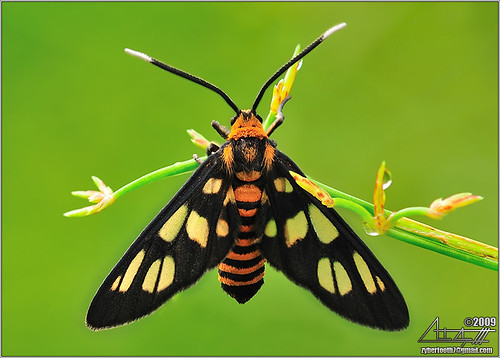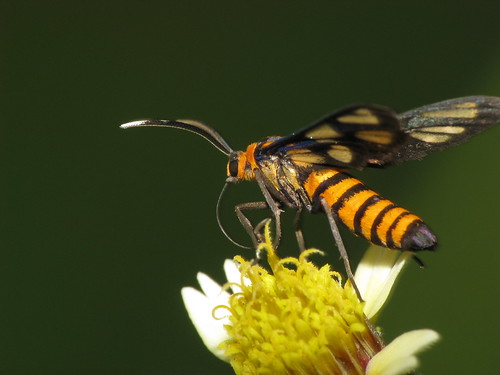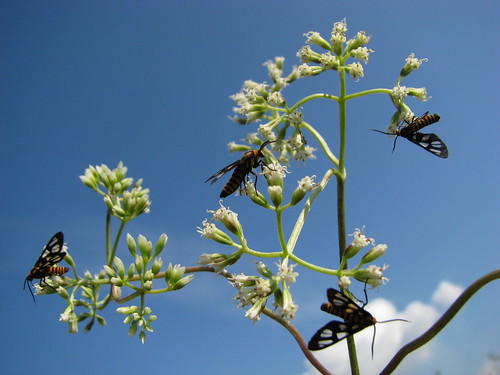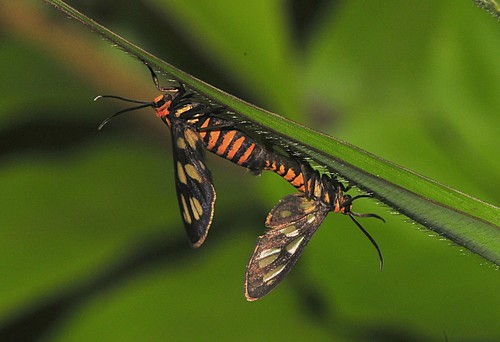
STOMPer Arborist spotted this strange insect, with a black and brown stripe body, and wonders what it is.
He says:
"I took this picture at a coffee shop at Bukit Batok St 21.
"As I was enjoying my cup of coffee I suddenly spotted this insect on a chair.
"It has a pair of antennae and a body with black and brown stripes.
"The wings are black with many holes covered with a transparent membrane.
"It is able to fly like a mosquito.
"Can some entomologist tell me what this insect is?"
This is a tiger moth (F. Arctiidae). One of the most common species locally is known as the day-flying moth (Amata huebneri), although it is possible that there are several other similar-looking species found in Singapore. This thread from the Nature Photographic Society, Singapore (NPSS) Forums features a sighting of another tiger moth species, Eressa confinis, from Sungei Ulu Pandan.

(Photo by zybertooth)
These moths can be very common in parks and gardens, wherever there are open patches with wildflowers for them to feed on.

(Photo by Siyang)
Unlike most species of moths, and as their name indicates, day-flying moths are diurnal, and are active during the day, where they forage alongside their cousins the butterflies.

(Photo by Siyang)
Day-flying moths are often found while mating.

(Photo by spiderman (Frank))
Oddly enough, despite being so common, it does seem that there are no images of the caterpillars of our local day-flying moths. This site reports that the caterpillars have been recorded feeding on rice (Oryza sativa) in Java, although I suppose they actually have a much broader diet.
I did manage to find this photo of the caterpillar of a relative, the nine-spotted moth (Amata phegea), found in Europe and western Asia. The caterpillars of many species of tiger moth are densely covered in fine hairs.

(Photo by notoriousxl)
This site and this site showcase several species of tiger moths found in Australia. Note that many species look very similar to one another, even those belonging to different genera. This particular group of tiger moths is classified under the subfamily Ctenuchinae, and also goes by the name of wasp moths, due to the superficial similarity to wasps seen in many species.
The conspicuous black and orange coloration of day-flying moths is said to be an example of aposematism, warning potential predators that they are poisonous or distasteful. As far as I know, this has not been studied in local species. Caterpillars sequester chemicals found in the plants they consume, retaining them into adulthood. It certainly would be very interesting to study the ecology of Amata huebneri, finding out what plants are consumed by the caterpillars, the chemicals acquired, the effectiveness of these compounds in protecting the moth from its predators, and exactly what animals prey upon this species.
Moths are a very diverse group, and compared to their more colourful cousins, the butterflies, have been somewhat overlooked. While butterflies in Singapore have advocates and champions such as the Butterfly Circle and the Butterfly Interest Group, no similar groups exist for moths.
It is true that a large proportion of moth species are drab and plain-looking, and that the nocturnal habits of many species deters most people from picking up moth-watching as a hobby, but that does not mean that moths are any less interesting or undeserving of attention. In fact, the Lepidoptera consists of 128 families, of which the 7 families of butterflies form only a single tiny branch. That's right, almost all lepidopterans fall under the label of 'moth', which is a darn shame, because it means that most of us remain oblivious to the sheer numbers of species of moth, as well as the dazzling diversity of colours and forms. Here are several sets on Flickr from Siyang, Marcus, Jacqueline Lau, Colleen Goh, Johnny Wee, and artour_a, featuring moths from Singapore and elsewhere in the region.
Flickr set by Siyang, created with Flickr Slideshow.
Siyang also runs the Moth Mania blog, which unfortunately has not been updated for some time already.